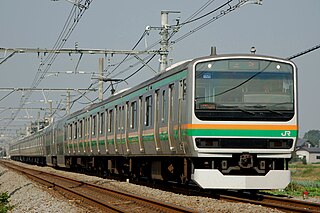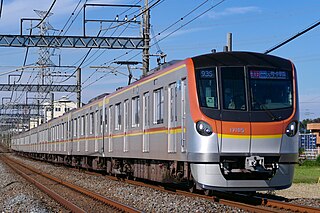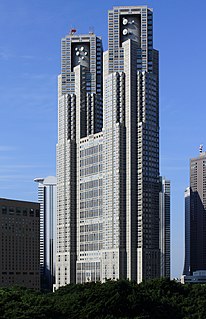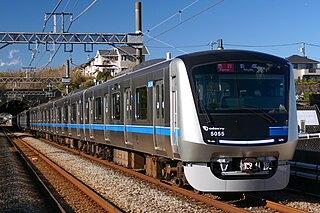Shinjuku, Tokyo held a local election for the city assembly on April 22, 2007 as part of the 2007 Japanese unified local elections.
| Parties | Votes | % | Seats |
|---|---|---|---|
| Liberal Democratic Party (自由民主党, Jiyū Minshutō) | 23,018 | 10 | |
| New Komeito Party (公明党, Kōmeitō) | 19,806 | 9 | |
| Japanese Communist Party (日本共産党, Nihon Kyōsan-tō) | 15,642 | 8 | |
| Democratic Party of Japan (民主党, Minshutō) | 10,990 | 5 | |
| New Socialist Party (新社会党, Shin-Shakaitō) | 2,358 | 1 | |
| Social Democratic Party (社民党 Shamin-tō) | 2,108 | 1 | |
| Independents | 8,216 | 4 | |
| Total (turnout 40.15%) | N/A | 100.00 | 38 |
| Source: Archived 2020-09-04 at the Wayback Machine | |||

Shinjuku is a special ward in Tokyo, Japan. It is a major commercial and administrative centre, housing the northern half of the busiest railway station in the world and the Tokyo Metropolitan Government Building, the administration centre for the government of Tokyo. As of 2018, the ward has an estimated population of 346,235, and a population density of 18,232 people per km2. The total area is 18.23 km2. Since the end of the Second World War, Shinjuku has been a major secondary center of Tokyo (fukutoshin), rivaling to the original city center in Marunouchi and Ginza. It literally means "New Inn Ward".

Shibuya is a special ward in Tokyo, Japan. As a major commercial and finance center, it houses two of the busiest railway stations in the world, Shinjuku Station and Shibuya Station.

Special wards are a special form of municipalities in Japan under the 1947 Local Autonomy Law. They are city-level wards: primary subdivisions of a prefecture with municipal autonomy largely comparable to other forms of municipalities.

Shinjuku Station is a major railway station in the Shinjuku and Shibuya wards in Tokyo, Japan. In Shinjuku, it is part of the Nishi-Shinjuku and Shinjuku districts. In Shibuya, it is located in the Yoyogi and Sendagaya districts. It is the world's busiest railway station.

The Shōnan–Shinjuku Line is a passenger railway service in Japan which commenced in December 2001. The line has no dedicated track as services run through shared sections along the Ryōmō Line, Takasaki Line, Utsunomiya Line, Yamanote freight line, Yokosuka Line, and Tōkaidō Main Line. It is treated as a distinct service at stations and on railway maps.

The Keio Line is a 37.9-km railway line in western Tokyo, Japan, owned by the private railway operator Keio Corporation. It connects Shinjuku, Tokyo, with the suburban city of Hachiōji. The Keio Line is part of a network with interchanges and through running to other lines of Keio Corporation: the Keio New Line, Keio Sagamihara Line, the Keibajo Line, the Dobutsuen Line, the Takao Line, and the 1,067 mm gauge Keio Inokashira Line.

Kabukichō is an entertainment and red-light district in Shinjuku, Tokyo, Japan. Kabuki-chō is the location of many host and hostess clubs, love hotels, shops, restaurants, and nightclubs, and is often called the "Sleepless Town". Shinjuku Golden Gai, famous for its plethora of small bars, is part of Kabuki-cho.

The Utsunomiya Line is the name given to a 163.5 kilometer section of the Tōhoku Main Line between Tokyo Station in Tokyo and Kuroiso Station in Nasushiobara, Tochigi, Japan. It is part of the East Japan Railway Company network.

The Takasaki Line is a Japanese railway line which connects Ōmiya Station in Saitama, Saitama Prefecture and Takasaki Station in Takasaki, Gunma Prefecture. It is owned and operated by the East Japan Railway Company.

Ichigaya is an area in the eastern portion of Shinjuku, Tokyo, Japan.

The Tokyo Metro Fukutoshin Line, formally the No. 13 Fukutoshin Line, is a subway line operated by Tokyo Metro in west-central Tokyo and Wako, Saitama, Japan. The newest line in the Tokyo subway network, it opened in stages between 1994 and 2008. On average, the Fukutoshin line carries 362,654 passengers daily in 2017, the lowest of all Tokyo Metro lines and roughly one third of its sister Tokyo Metro Yūrakuchō Line (1,124,478).

The Toei Shinjuku Line is a rapid transit line in Tokyo and Chiba Prefecture, Japan, operated by Tokyo Metropolitan Bureau of Transportation (Toei). The line runs between Motoyawata Station in Ichikawa, Chiba in the east and Shinjuku Station in the west. At Shinjuku, most trains continue as through services to Sasazuka Station on the Keiō New Line, with some services continuing to Hashimoto Station in Sagamihara, Kanagawa via the Keiō Line and the Keiō Sagamihara Line.

The Seibu Shinjuku Line is a Japanese railway line owned by the private railway operator Seibu Railway, connecting Seibu Shinjuku Station in Shinjuku, Tokyo with Hon-Kawagoe Station in Kawagoe, Saitama.

The Keio New Line is a 3.6 km link which connects Keio Corporation's Keiō Line from Sasazuka Station in Shibuya to Shinjuku Station with through service on to the Shinjuku Line of the Tokyo Metropolitan Bureau of Transportation. The line opened on October 30, 1978.

The Odakyū Enoshima Line is a branch line operated by the Japanese private railway operator Odakyū Electric Railway in eastern Kanagawa Prefecture. The Enoshima Line branches from the Odawara Line at Sagami-Ōno, extending south to Fujisawa and Katase-Enoshima, a distance of 27.6 km. It was completed with 13 stations on April 1, 1929.

The Tokyo Metropolitan Government is the government of the Tokyo Metropolis. One of the 47 prefectures of Japan, the government consists of a popularly elected governor and assembly. The headquarters building is located in the ward of Shinjuku. The metropolitan government administers the special wards, cities, towns and villages that constitute part of the Tokyo Metropolis. With a population closing in on 14 million living within its boundaries, and many more commuting from neighbouring prefectures, the metropolitan government wields significant political power within Japan.

The Odakyu Tama Line is a railway line operated by the private railway operator Odakyu Electric Railway in the Greater Tokyo of Japan. The line extends 10.6 kilometres (6.6 mi) from Shin-Yurigaoka Station in Kanagawa Prefecture to Karakida Station in Tokyo.

Hon-Atsugi Station is a major passenger railway station located in the city of Atsugi, Kanagawa, Japan, operated by the private railway operator Odakyu Electric Railway.